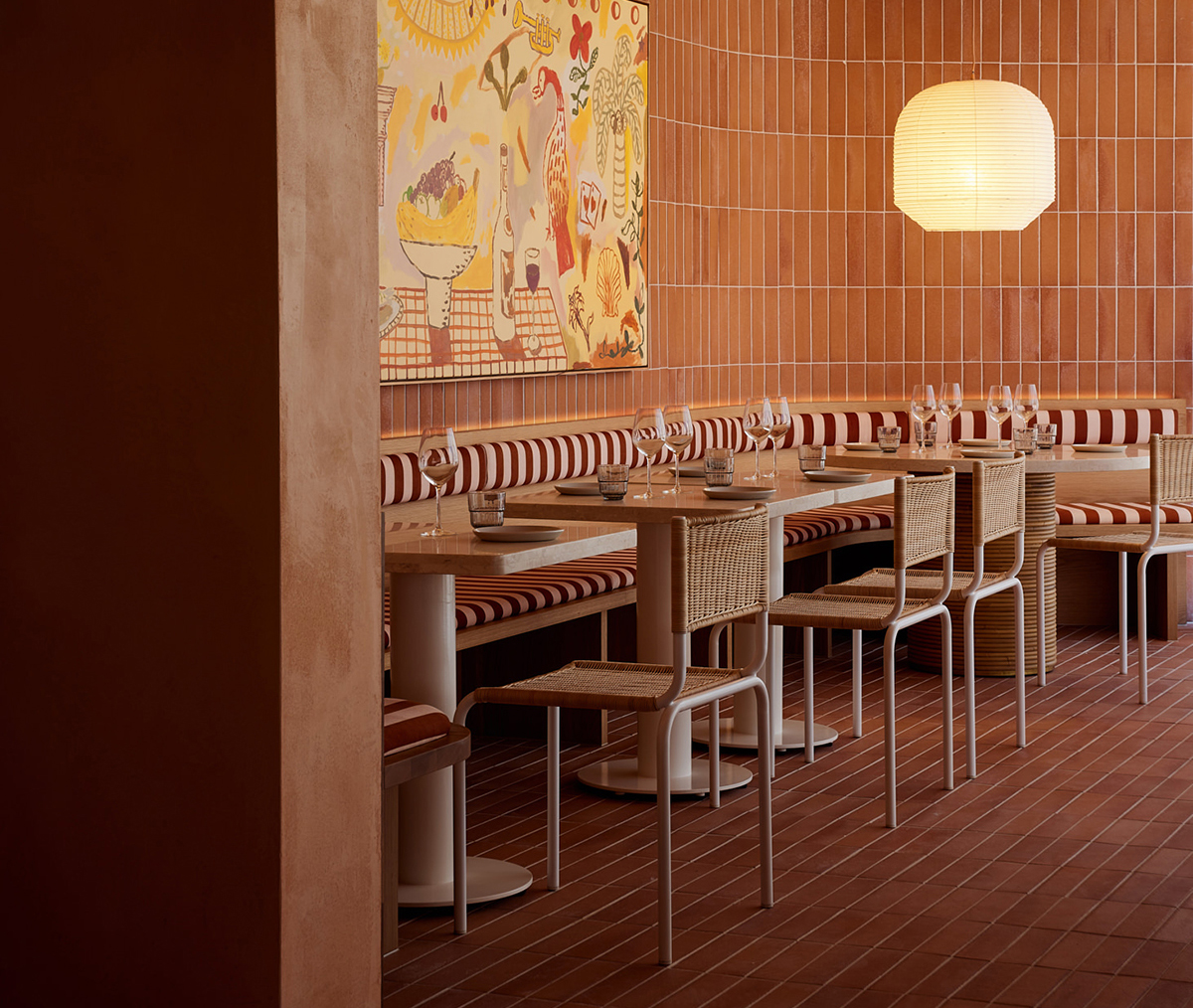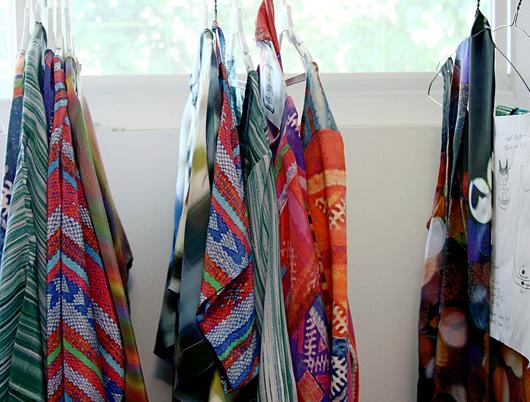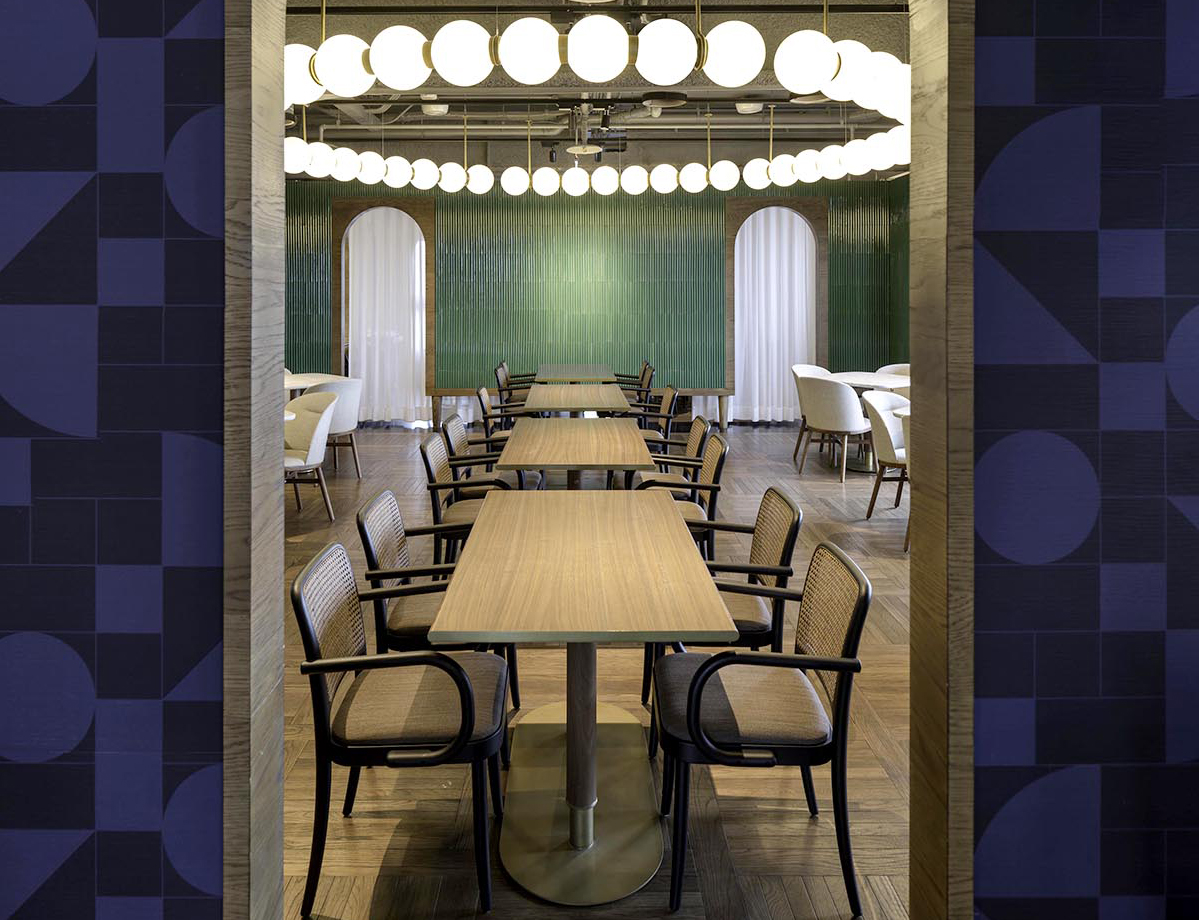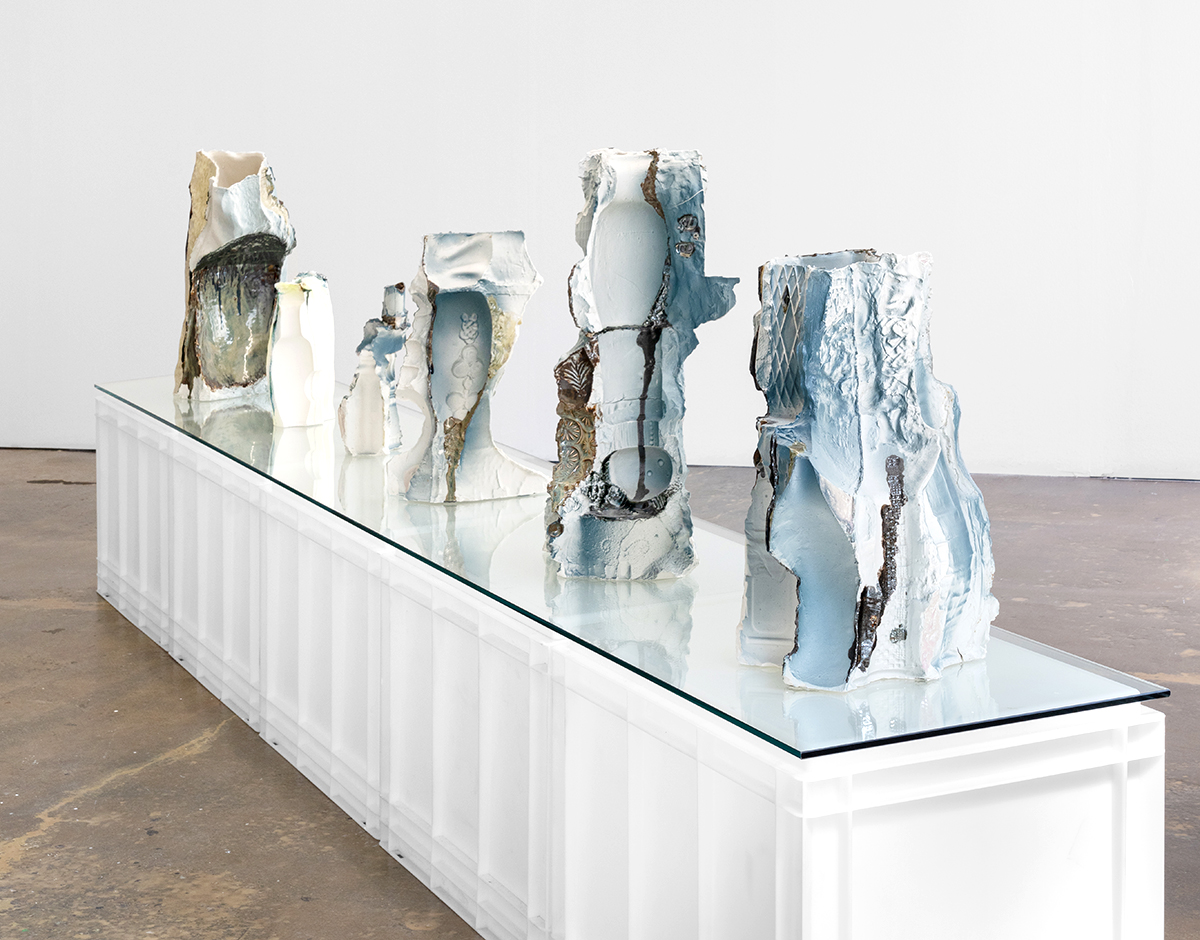
05.12.23
Excerpt: Exhibition
Meet the NYC Art Collective Who Brought Their Explorations of “Vaguely Asian” Identities to Milan
Comprising four New York City–based artists, the collective CFGNY — commonly known as Concept Foreign Garments New York — employs an unruly creative output to assert their own lived experience of being what they call “vaguely Asian” in America. When founders Tin Nguyen and Daniel Chew met in the downtown art scene in 2016, they observed an environment that not only tokenized Asian creatives but seemed to ask them to compete with one another. With a shared tendency to push against convention, the pair chose instead to collaborate. Their initial garment-making projects drew both acclaim and confusion for the way in which they used fashion to scramble notions of pure Asian identity.
Since joined by artists Kirsten Kilponen and Ten Izu, the group recently staged an exhibition called Emporium during last month’s Milan furniture fair — presented by Italian leather brand Marséll and curated by PIN-UP magazine’s Felix Burrichter — that employs cardboard, porcelain, and leather to further complicate this idea of a blurry Asian-ness. The sculptures created with Marséll especially for the show, like leather-wrapped replicas of architectural details from Milan’s Chinatown, elucidate contact points between cultures and identity groups. Bootlegging, luxury economies (especially as they grow into the Chinese market), global commodities, vernacular architecture, and even the nature of collaboration within their own collective are the subjects of other works as diverse as porcelain casts of bottles and vases and rooms built entirely of cardboard.
Rejecting the rigidity of “authentic” culture or identity groups, CFGNY’s work affirms the fluidity of what it means to be Asian in a modern context. Talking about this nebulous, shared experience requires complex forms of language, and the collective’s thoughtful treatment of materials in Emporium offers us a starting point for that conversation, one which we’ve continued in the interview below.
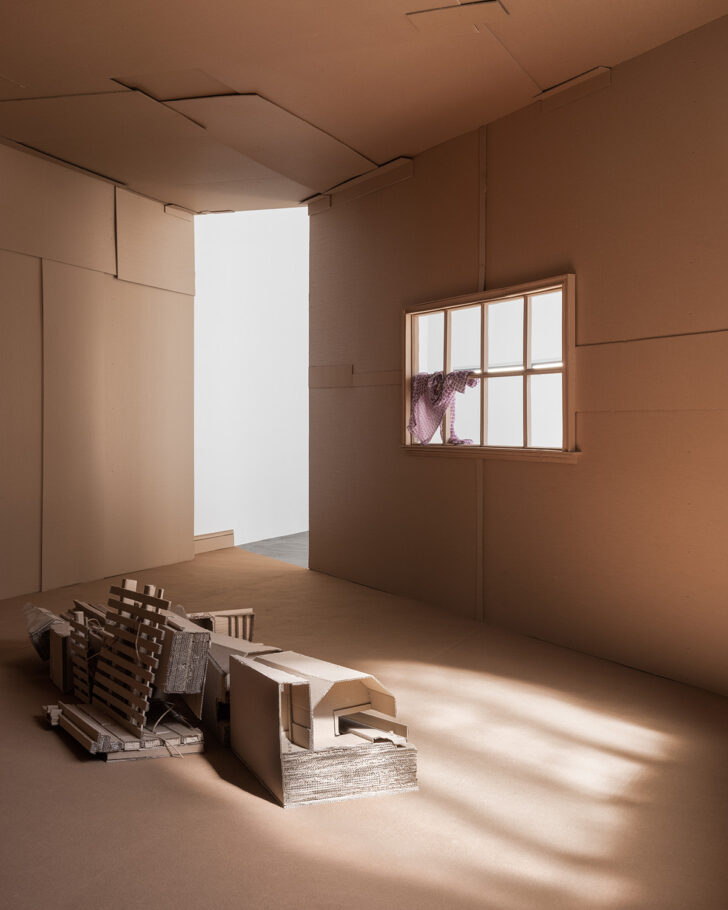
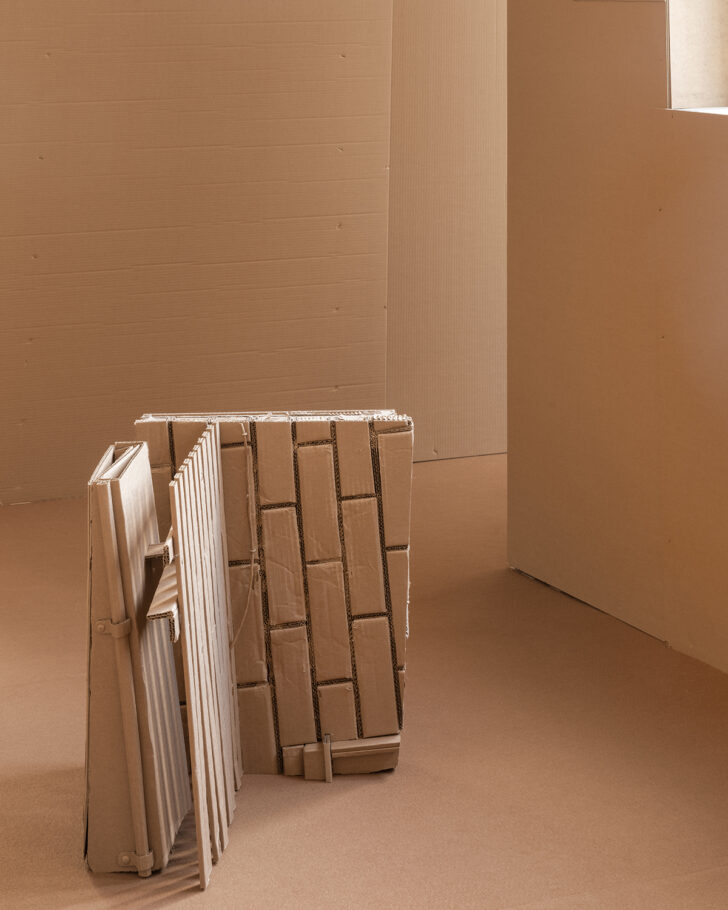
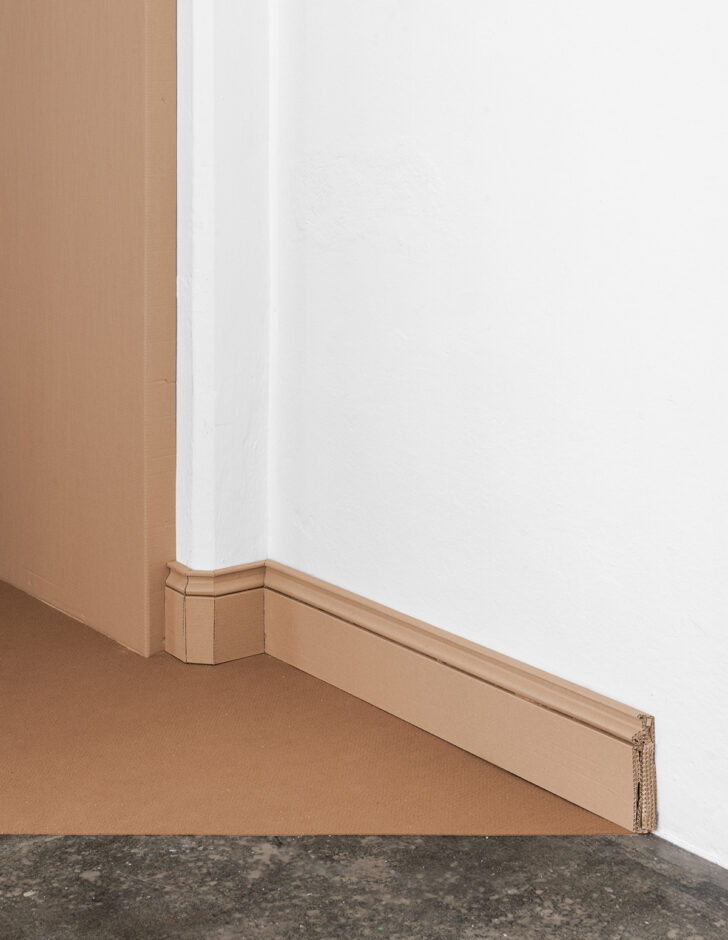
Before we jump into the Emporium show you just exhibited in Milan, tell us a bit about who you are. What is CFGNY?
Daniel: Oh my God, this is such a huge question! I would say first of all that we’re artists. And so everything that we do, like fashion, or things that also look like design or sculpture, we approach from the perspective of an artist. The show during Salone is the first time that we’ve been presented within a design context. There are four of us — Tin, Daniel, Kirsten, and Ten. We all came together in the downtown art scene in the 20-teens. A lot of our work circulates around the concept of the “vaguely Asian,” which isn’t interested in pinpointing any kinds of authenticity, purity, or single source of origin for Asianness, but is moreso interested in plurality, collaboration, and affect. Our work takes the form of sculpture, installation, performance, photography and videos, and fashion research.
How did that idea of “vaguely Asian” manifest itself in your initial projects?
Daniel: Tin and I started working together in 2016 as a sort of garment-making project. We were both hanging out in the art world, which at that time was seemingly very white, I would say. So you would always very easily recognize all the other people who kind of looked like you within that social scene. And so me and Tin, both being gay and Asian, began to notice each other and started up a conversation trying to figure out what it meant to be Asian within this very white scene. And what we could see around us was that to be Asian was to be tokenized — or to even compete for that spot of being even tokenized.
We saw a lot of Asian people being very competitive with each other, and so we said why don’t we try to do the opposite of that and collaborate? Have this conversation between ourselves but then also see what sort of material conversation comes out of that.
In the beginning I think we chose garment making because Tin and I were going to a lot of sample sales together (laughs). We love to get cheap designer clothes and deals. And what we saw emerging was this kind of “vaguely Asian” sensibility which we grew to base our whole project and discussions around. Tin, who’s Vietnamese, grew up getting clothes made by his mom whenever she went back to Vietnam on these tourist streets. It’s an industry that exists not only in Vietnam but in places like Hong Kong, where you can get suits made in like two days in these garment-making districts.
Right, we have the same exact thing in the tourist areas in Thailand!
Daniel: Exactly. So, Tin and I thought, why don’t we try to just make a full collection on these tourist streets? And it also became a way for us to try to spend more time in Asia. The material conversation that we were having with the tailors who were making our clothes became a big part of the project. Their tailoring style was geared towards an expat/foreigner market, and by contrast we were asking them to make clothes for us that reflected a kind of diaspora identity. Tin and I weren’t trained in fashion design at all ,and so we would give them a sample or drawing, and then just let them use their expertise as garment makers to find the right seams and folds — just let them make all the decisions for us.
So we’d get these garments back from the tailors and for example a collar or a cuff would be shaped in a very particular way, and we would ask them, “why did you make this decision?” And they would say something like, “Oh, well we know you’re Westerners, and we know what Westerners like because we work with them so much.” So a lot of these little details were incorporated into the final designs of our garments, and really represented this sort of “vaguely Asian” thing that we were talking about. The perception of each other is what informed the material output of what we were actually making.
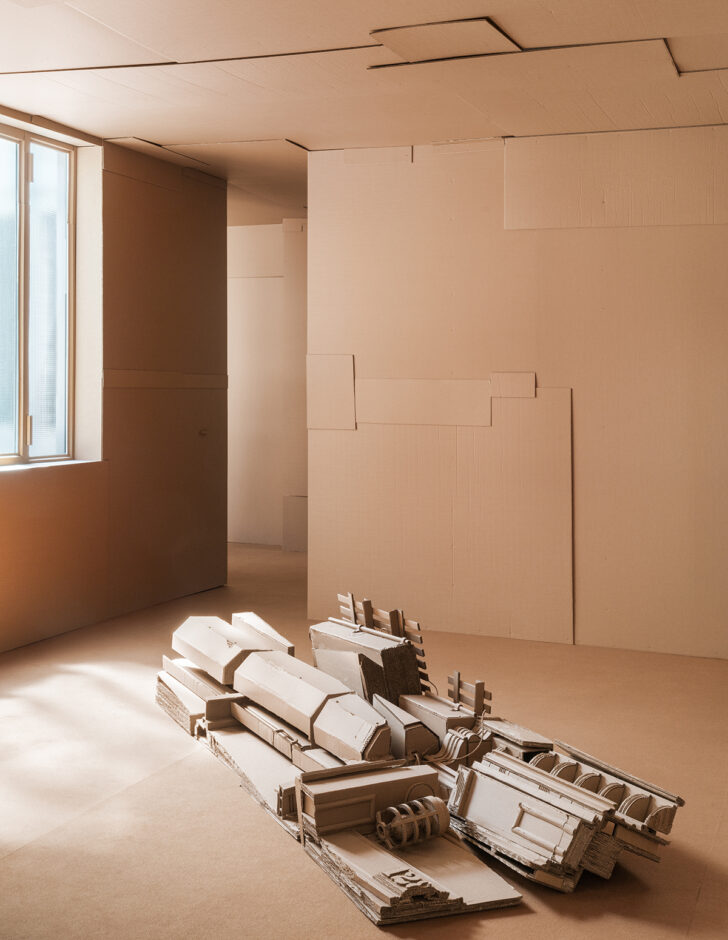
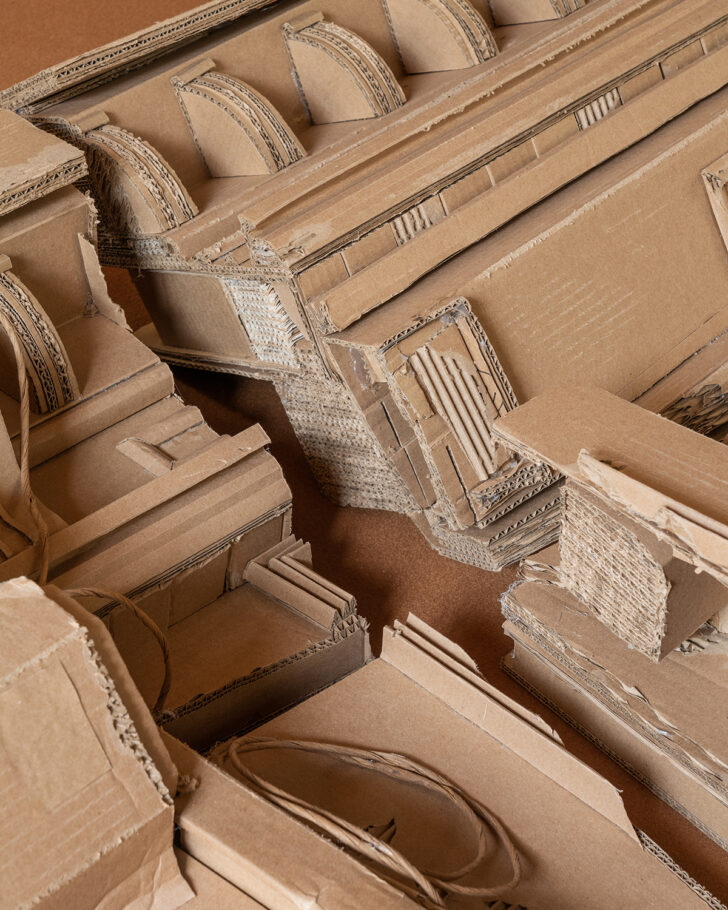
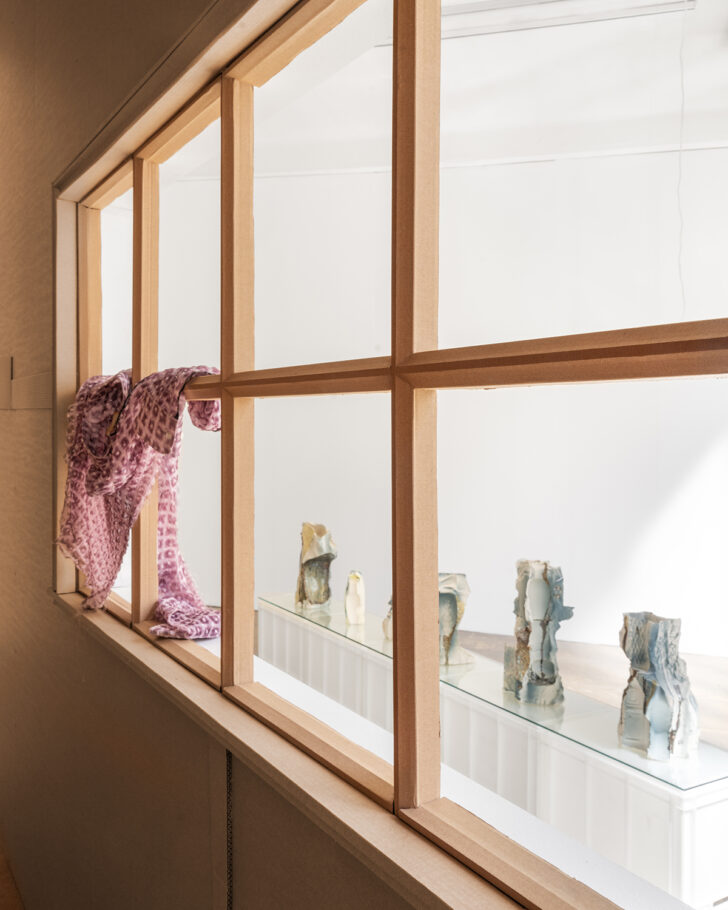
That concept of indefinability and leaving room for a plurality of viewpoints is essential in all of your work. Tell us about how that was applied to a new material or medium for the Emporium show.
Ten: In a lot of our previous work we’ve always worked with cardboard. And the initial starting point for working with that material was seeing the cardboard box check-in luggage on flights going to and from Southeast Asia. It’s kind of the most maxed-out, economical form of bringing goods back and forth on a smaller scale within our industrial global economy. We’re interested in cardboard because even though it houses all these goods, it kind of leads to a racialization of both products and people. It’s this super-cheap, universal, and anonymous form that is a skin for all these materials, that then shapes narratives about trade and diaspora. It parallels the kinds of material conversations that happen around the world, especially between the US and Asia.
This reminds me of an experience I had a couple years ago, when I brought a box back from Thailand. The TSA agent searched it and told me explicitly, “If you pack a box, then we’ll search it 100% of the time.” So the context you’ve provided makes me realize that this cardboard box, besides being a protector of what’s inside, was also a kind of racialized marker. Like it’s an alien skin that the TSA agent felt the need to peel back to make sure there wasn’t something nefarious or illicit on the inside.
Daniel: I also think it’s a class marker, besides being a racialized marker. Because if you’re a rich person, you’re not going to pack your bags that way.
Ten: We actually brought that whole sculpture to Milan in four giant boxes that definitely got searched by TSA. They were all like, “What’s in this?” and we’re like, “more cardboard” (laughs).
We’ve brought together a lot of different materials for the show. We consider fashion a material; we consider architecture to be both history and a material. In one of the rooms in the show, we made a kind of facsimile of a facade of this building in Manhattan’s Chinatown that we consider to be a form of vernacular architecture. In downtown Manhattan there’s a lot of really old buildings that just have stuff crusted all over them from decades of continuous use. It’s kind of built itself slowly over time.
Daniel: And I think we’re also interested in the unplanned aspect of that. It looks “vaguely Asian” to us in that it’s a sort of global South aesthetic, where the use or functionality of a space dictates how it’s formed, rather than being preplanned. 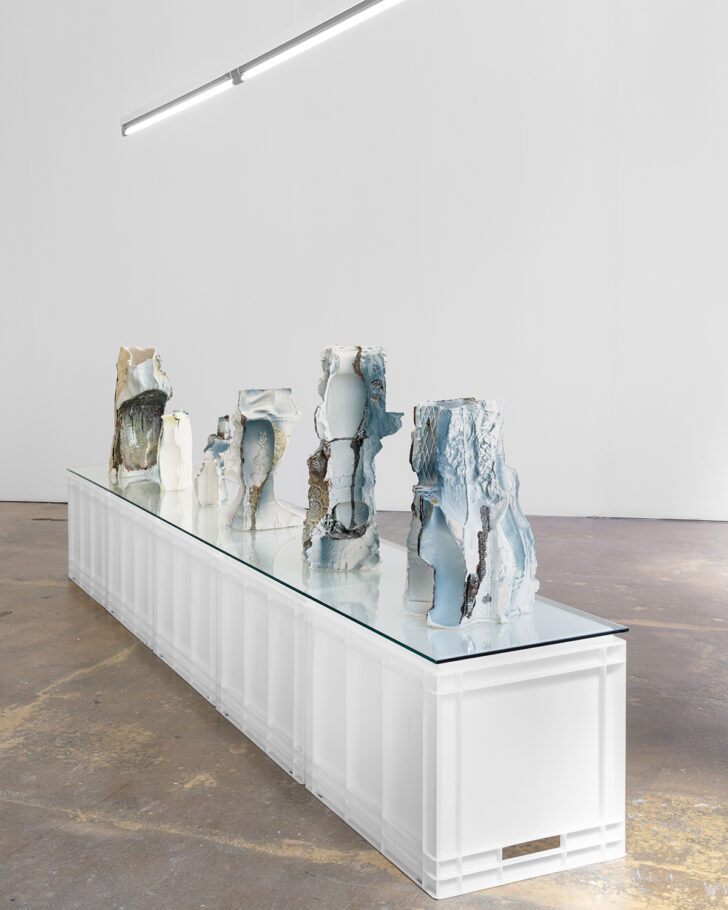
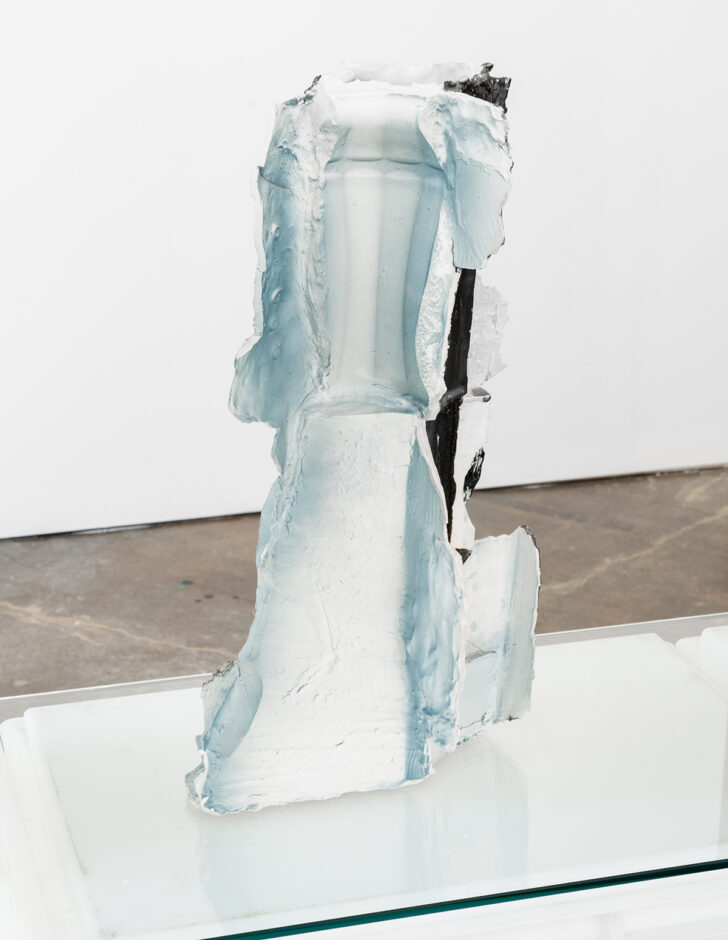
Right, this way of building over time is almost essential to the immigrant experience, especially within Asian communities like that in Chinatown. You almost see parallels to that in Asia, where new houses are left with rebar sticking out of the top of columns, so that you could add additional floors on the top in the future when finances allow. It’s only half planned.
Ten: Yeah, we’re really interested in how architecture serves as a kind of physical metaphor of historical infrastructure, as well as in how we navigate power and socialization within any given place.
Tin: We were also relating the aesthetic to the term “bootleg” and thinking of the bootleg not only as counterfeits, but also as a kind of tendency — a gesture of how one treats a material. And within that kind of vernacular architecture, the idea of the bootleg comes up too — thinking about how it communicates identity or racialization.
It seems like place is an important aspect of your work. The acronym CFGNY is usually noted as meaning Concept Foreign Garments New York. But you also leave it open to interpretation, and I’ve seen things like Cute Friend Group, or Cornfield Growers. But the NY always stands for New York. How does your relationship to the city, or specifically Chinatown, inform what you’re creating?
Ten: I think in the extremely zoomed-out sense, the US has had the longest history of a relationship in terms of conceptualizing Asia with China. Chinatowns are the oldest presences of Asia as a concept within the US. And therefore they’re also the first blanket term for anyone who looks like they’re from this area that is called “Asia.” So it’s like we come together because of this shared experience of racialization and alienation that happens when you’re perceived as belonging to this idea of a racialized monolith, even though we’re all from different racial backgrounds or ethnic backgrounds within the Asian diaspora. And Chinatown is this central neighborhood where we all met each other around the downtown gallery scene, as well as where we like to hang out and go shopping and buy food and stuff. So I would say that’s one reason why we congregate around it.
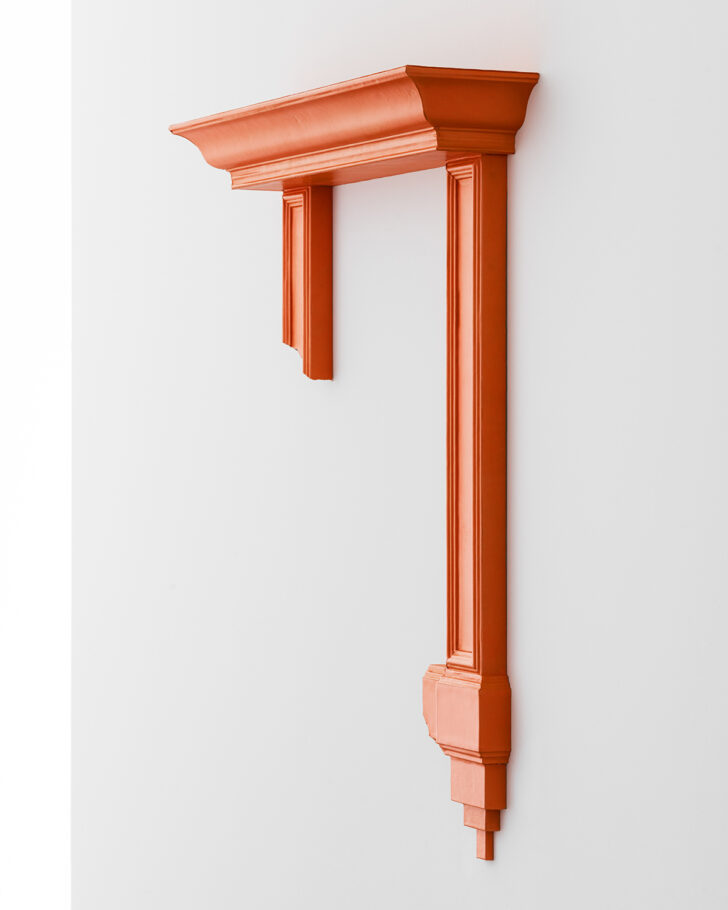
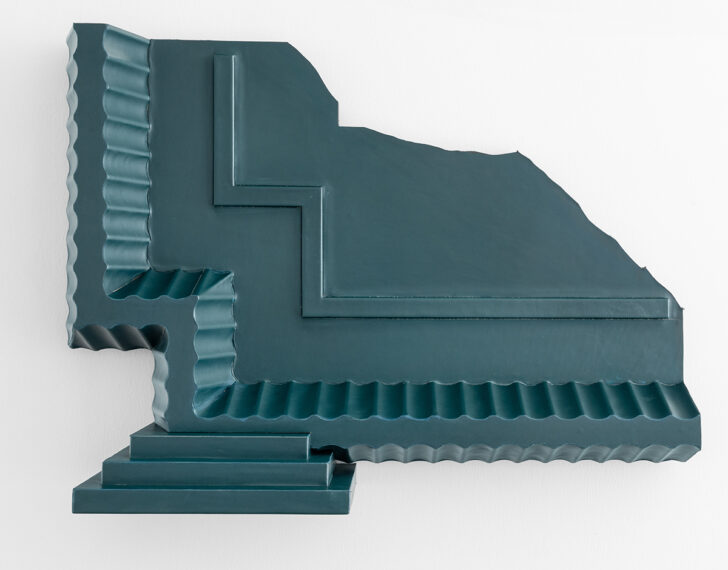
I remember you using Chinatown as a backdrop for previous exhibitions, for example a runway show in Seward Park. There seems to be an intimacy when you display your work there. How does that idea of place change when you bring your work to a venue like the Salone in Milan, which is the design world’s annual event of chicness and glamour? Does the work or experience change when you put it into this new context?
Daniel: While place has played a big role in our projects in the past, I think because CFGNY is not necessarily interested in a specific identity or trying to figure out a sort of “heritage” or some “authentic” kind of roots, but is rather more interested in moments of contact between different kinds of races and different populations, in this context we can see the processes of racialization that comes along with these meetings. That’s why the Salone made sense for us to show in, because of the nature of Italy’s economy. We worked with Marséll — a luxury leather and shoes company — and one of the first things that they told us was, “Our first international market was in China.”
Do you think that’s a reason they wanted to work with you?
I can’t tell for sure, but I think maybe a little bit yes. It created a sort of research path for us to look into. Italy’s economy is based around the luxury market, and increasingly the biggest share of luxury consumers in the world — I think it’s estimated to be 40 to 45 percent by 2025 — are Chinese. There’s been a really big push within Italy to market itself as a luxury capital, and the Salone is a really big part of that. The reason why the fair was delayed last year actually was because they were waiting for Chinese people to be able to actually come in 2022. But then that didn’t even happen because China just didn’t open up. So I think our work is dealing with this sort of perception of Asian-ness and the way in which, all over the world, there’s contact between different sorts of forces, races, and operations.
Tell us about one of the leather sculptures you collaborated on with Marsell.
Ten: We were interested in working with leather for its existence in the global imagination as a specifically Italian luxury good. The cultural conceptualizations of a place or people are central to our work. The leather works, the production of which were facilitated by Marsèll, are recreations of architectural details from via Paolo Sarpi in Milan, the street considered the heart of Chinatown. In looking at them, they resemble architecture from the rest of Milan. In that way, these works are shown in opposition to the New York City reference in the show, which is a recreation in cardboard in eight parts of two buildings intersecting in the Chinatown portion of Manhattan. This particular fragment interested us because of the way in which it exemplified a vernacular architecture that we consider to be “vaguely Asian”: The architecture is unplanned, but becomes formed through years of use and practical considerations. In its chaos you can read a sensibility that motions towards immigration histories and class background that reaches beyond national borders. When engaging with architecture, we’re looking at how physical spaces bear the marks of the people who have existed within them, and how physical structures can illustrate historical narratives. 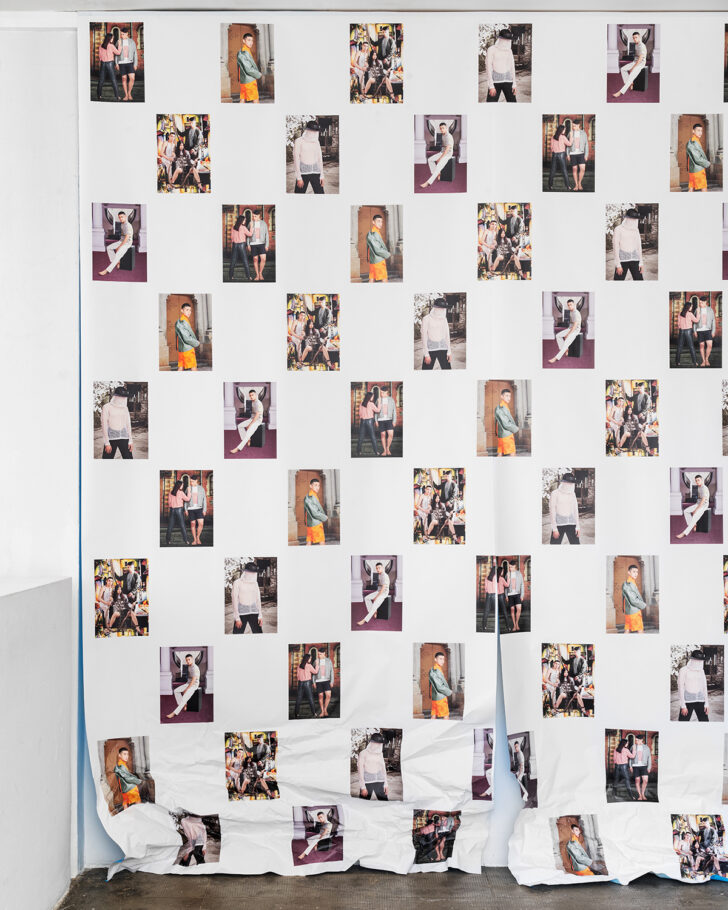
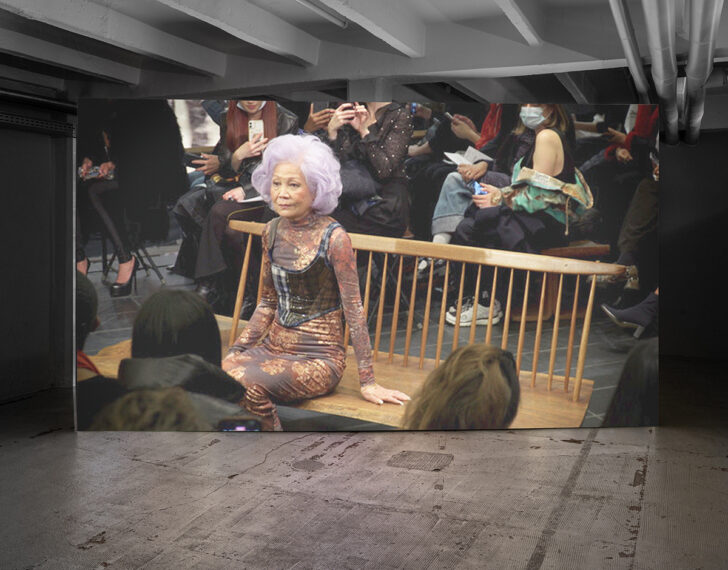
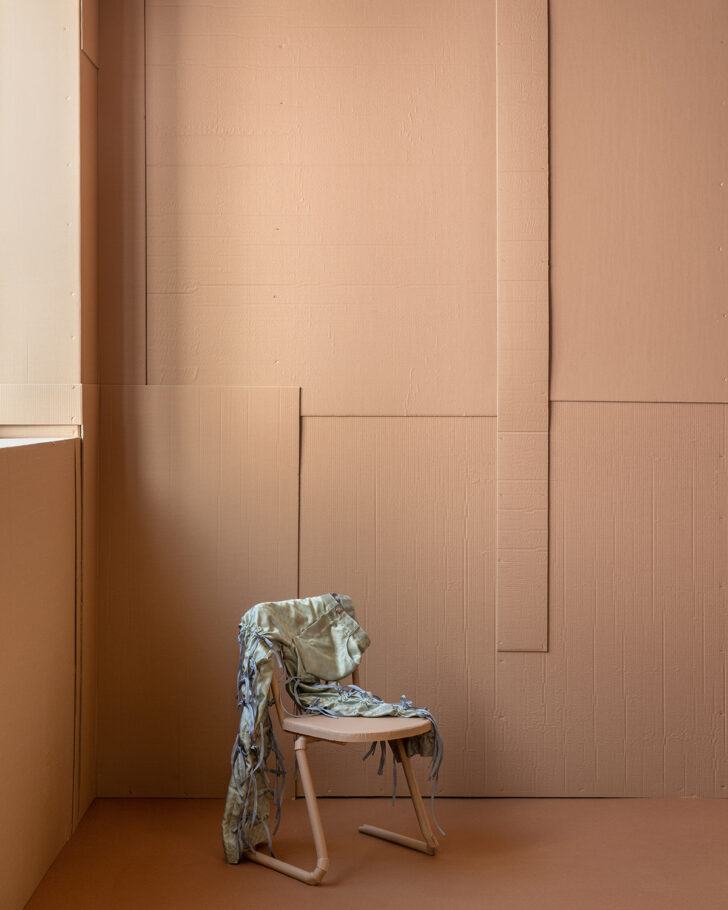
And what about the porcelain series. I saw you describe them as a kind of “third degree echo” due to the fact that they’re actually showing the negative space left over from the series of objects they were cast from. Tell us more about how those pieces came into being.
Tin: I have a history of making ceramics since I was young, and Ten has a practice that includes ceramics as well. So when Ten joined CFGNY, we started exploring how we could collaborate with one another not just as a group, but also as individual selves. The work and interest changes.
We did a project in 2018 that was commissioned by Triple Canopy at the RISD Museum, and it was part of this exhibition called Raid the Icebox Now, which was a 50-year anniversary show for the Andy Warhol exhibition. They invited different collectives or artists to approach each part of the museum’s collections. Triple Canopy and was assigned the Pendleton House, which is the first American wing in the United States, and it’s a collection of objects that were donated from this colonial man. They basically recreated and furnished his house with all of his objects, and there’s all this Chinese furniture and porcelain that was collected during that time. We were interested in these pieces as racialized objects, so that became our first introduction to porcelain within CFGNY.
What was it like working with Marsell on the leather piece? Are you letting go of creative control when working with craftspeople?
Ten: There’s an element of us trying to guide them, but also a letting go of control that’s inherent in all of the works. One of the funny things about being an artist — or a designer as well — is so much rests on your own creative ego. The difference between that and working in a collective is you have to let go of that aspect of total control. We’re interested in the idea of polyvocality, and racial socialization being an ongoing project. So for the leather works in the show, we had all these reference images that we wanted them to make, with little Photoshop mockups of the types of sculptures with the finishes that we were interested in. But ultimately we were just like, okay cool, once they showed us what they were making.
I’m guessing you had to collaborate remotely, which feels more realistic in the context of this overall theme of global trade and commodities. It’s so diffused.
Ten: When we work with different people we see it as a material conversation, so it’s not directional. And we’ve never worked with leather, so it’s not our expertise, but in doing so we just set parameters and then let it go from there.
Another good example is a project with the X Museum in Beijing. We designed a kind of chopped and screwed version of the Met’s American Wing, and specifically wanted to work with the curatorial assistant and installation team as opposed to the curator. We gave them a mood board PDF of all the decor that we wanted them to source. We were more interested in them — without their having an architecture or graduate-degree-level Western art-history background — interpreting our mood board and defining what “American” looks like. The assistant would just send us tons of images of “American” home décor, and we would just say great, and not give much feedback. So they were making all these decisions for us. This was also during COVID, so we never actually got to see any of it in real life.
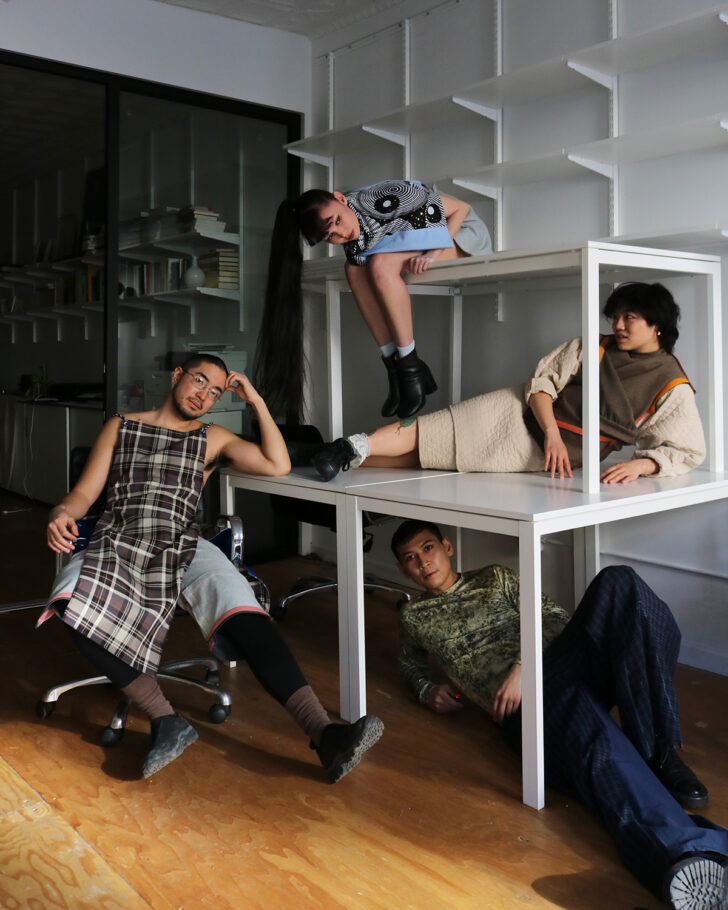 This big theme in the Emporium show of examining commodities and global trade, do you think that they relate to notions of Asian-ness moreso than they do to other so-called “identity groups”?
This big theme in the Emporium show of examining commodities and global trade, do you think that they relate to notions of Asian-ness moreso than they do to other so-called “identity groups”?
Daniel: I think it’s less that there’s some type of inherent strong connection between commodities in Asia, but more the fact that many of our commodities in the world today are made in Asia. And the rise of the global economy is based on this small commodity manufacturing. So it’s speaking more to how global trade is structured right now versus the idea of Asians’ being attracted to commodities. It just feels like we’re in a shifting moment of where objects are made, and there’s a tension in the world right of like, who’s profiting? Where are things coming and going to? It’s a specific moment, because goods were made in other countries at other points in time.
There’s also always been this idea that goods that come from this region should be cheap. The phrase “made in China” can have such a negative context here in the US. It’s like the main defining value is that something was made cheaply, but that isn’t necessarily true and fails to capture the full dynamic.
Tin: Right, and just because something was made with a lower cost doesn’t mean that it’s less valuable, either.
Ten: I think people are confused. One thing that’s specific to us is that we’re queer and not white. So people will say, if you’re a subaltern, why are your garments so expensive? And then we wonder, why do you conceive of the garments we make as having to be cheap? It’s implied that as these ultra-rare minorities we need to be making cheap-ass garments. This in addition to the fact that we’ve normalized paying nothing for garments because of the exploitation that happens in the industry.
You’re exploding conventional assumptions about identity, but also blurring lines between disciplines. That makes me wonder, have you encountered any gatekeeping or lane-keeping?
Daniel: I think we just have attracted people who have really responded to our project. We’re also just starting; we’ve only been doing this for a few years but we’re not the biggest thing ever. So there might have been some gatekeeping, but we just don’t even know because we were doing our own thing. Like maybe we literally weren’t even let in (laughs).
Tin: I would say one thing that’s difficult is that because we make garments, people see us as a fashion label. But in reality, we’re artists who use fashion as a kind of readymade. We’re all based in the art world, but the art world doesn’t really know how to conceive of our practice, nor are we interested in participating in the fashion economy. So I think the difficulty comes from kind of navigating these two different infrastructures, and trying to figure out where we can get, and how we can support ourselves within those infrastructures.
So, what’s next for CFGNY?
Ten: Opening a bar! We’re doing a residency at Sculpture Center in Long Island City for the whole summer. We’re their first residency artists, and we’re taking over the entire basement starting in mid-May. We’ll be having a permanent store there through the summer and will be using part of it as our studio. We’re opening a bar that we’re curating artists into, and we’ll be the bartenders. And then we’re also going to be organizing some screenings, and I think two club nights where we turn the whole thing into a club.
We’re interested in continuously confusing our audience and viewers. This residency is also a way for us to get more of the people that we’re working with involved. Some of our models will be showing art or throwing their own parties. It’s a continuation of the dialogue that we’ve started between everyone who’s involved in our project. ◆
